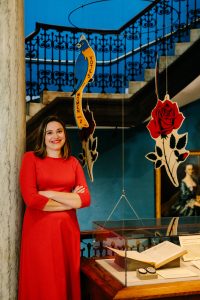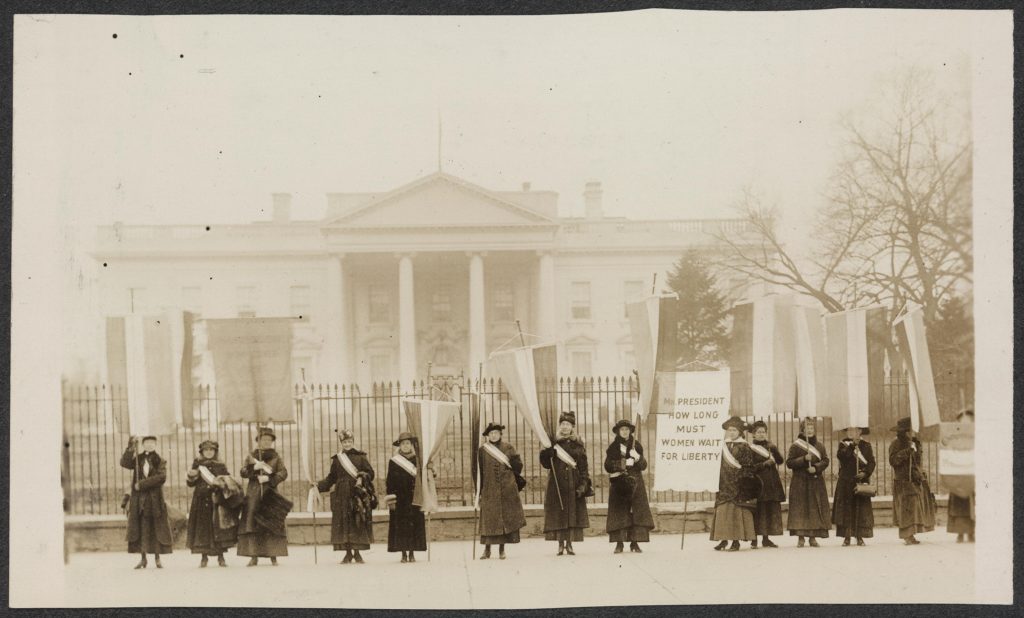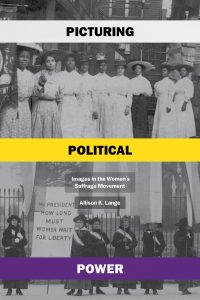Talking About Women’s History: A Whole Bunch of Questions and an Answer with Allison Lange
Allison Lange is a historian who explores the stories that pictures tell about the intersection of gender and power in U.S. history. She writes, gives talks, teaches and curates exhibitions dealing with American women’s history. She is an associate profession of history at the Wentworth Institute of Technology in Boston and served as Historian for the United States Congress’s Women’s Suffrage Centennial Commission.
Her first book, Picturing Political Power: Images in the Women’s Suffrage Movement, focuses on the ways that women’s voting rights activists and their opponents used images to define gender and power. She is current working on a book that situates contemporary iconic pictures within the context of historical ones to demonstrate how today’s visual debates about gender and politics are shaped by those of the past. As she puts it “For me, Instagram isn’t just a social media site it’s a research data base.”
Take it away, Allison:
Your work focuses on the historical use of images in debates about gender, power and politics. What do we learn when we use images as more than just illustrations?
Just like today’s images, historical images are not objective. The creators had a point of view, so it’s important for us to critically analyze them the same way we analyze texts. Images can reflect and reinforce ideas about social constructs like gender, but they can also establish new ones. By analyzing images, we gain a more complex understanding of the media that people in the past encountered and the ways it shaped their world.
Did a particular inspire you to work on images in the women’s suffrage movement?
The photographs of suffragists picketing the White House in 1917 are iconic. When I was considering research topics, I wondered why the pictures from this series were taken. Why did a professional photography studio go to the White House? What were these photographs for? Who saw these photographs in 1917? These photographs turned out to be revolutionary suffrage images that were central to keeping the fight for suffrage in the news and forcing lawmakers to address the issue.
How do visual debates about gender and politics continue today?
We encounter visual debates about gender and politics almost constantly. For example, Instagram is a fascinating place to examine the ways that we represent ourselves to a public audience. While artists, editors, and publishers had more power over someone’s image in the 19th century, today public figures have slightly more control over the images they share with the public. Yet, in some ways little has changed. Popular media often still imagines feminists and female political leaders as masculine revolutionaries, and women in politics still work especially hard to make themselves appear approachable, feminine, and–often–motherly.
In addition to writing about women’s history, you have curated several exhibits for a number of museums. How does telling history in a visual or multi-media form differ from writing history for the page?
Writing brief explanatory label texts is like a puzzle. I want scholars to read them and see the story’s complexities, but I also want a group of middle schoolers to grasp the basics. It’s a challenge to fit both stories into a few sentences! I also rely on the artifacts to help tell the history. The process of writing these texts has taught me to write clearly and concisely, which is helpful for writing a book too.
What work of women’s history have you read lately that you loved? (Or for that matter, what work of women’s history have you loved in any format?)
I love work that makes women’s history accessible to a general audience. For example, the American Girls podcast hosted by historians Allison Horrocks and Mary Mahoney provides critical analysis of the beloved book series and its representation of the past in combination with commentary on popular culture. I’m also really enjoying Dickinson, a show about the poet Emily Dickinson. It celebrates her poetry and is a wonderful reminder that women in the mid-19th century had fun!
If you could pick one woman from history to put in every high school history textbook, who would it be?
Mary Church Terrell. No question! As Alison Parker’s amazing new book Unceasing Militant shows, Terrell was born enslaved and grew up to be a leading activist in the movements for civil and women’s rights. Plus, she loved fashion and had a fascinating, complex personal life.
Who are some of your favorite authors working in women’s history today?
There are so many extraordinary authors! It’s impossible to choose just one. Lately I’ve been amazed by the wealth of new scholarship on the history of women’s voting rights, including wonderful books by Cathleen Cahill, Kimberly Hamlin, Martha Jones, Laura Prieto, Wendy Rouse, Lisa Tetrault, and so many more.
What do you find most challenging or most exciting about researching historical women?
I love researching historical women. Sometimes learning about their lives can be frustrating and even infuriating, but it can also be inspiring to see what they accomplished even under difficult circumstances.
Do you think Women’s History Month is important and why?
Until we have more women’s history in school curriculums, Women’s History Month remains important. State standards require students to learn little about the lives of historical women. Women’s History Month programs provide important opportunities for engagement with female figures.
How do you define women’s history?
Women’s history is necessarily broad. The field overlaps with every other historical field, from the history of families and labor activism to politics and the institution of slavery. Social constructions of gender are central to women’s history. Those constructions are constantly changing, as is the field and everything it encompasses.
A question for Pamela: I’d love to know: what is your current favorite women’s history content–fiction or non-fiction book, movie, tv show, podcast, etc–right now?
There is so much good stuff out there right now that it’s hard to chose. I’m loving Sonia Purnell’s A Woman of No Importance and Judy Batalion’s The Light of Days. (I’m immersed in World War II right now.) As far as podcasts go, it’s hard to beat The What’s Her Name podcast, the Exploress and the Dead Ladies Show. Ask me again tomorrow and you might get different answers.
* * *
Want to know more about Allison and her work?
Check out her website: http://www.allisonklange.com/
Follow her on Twitter: @aklange1
* * *
Tomorrow it will be business as usual here on the Margins with a blog post from me. But we’ve still got more people talking about women’s history from a lot of different angles next week. Don’t touch that dial!







